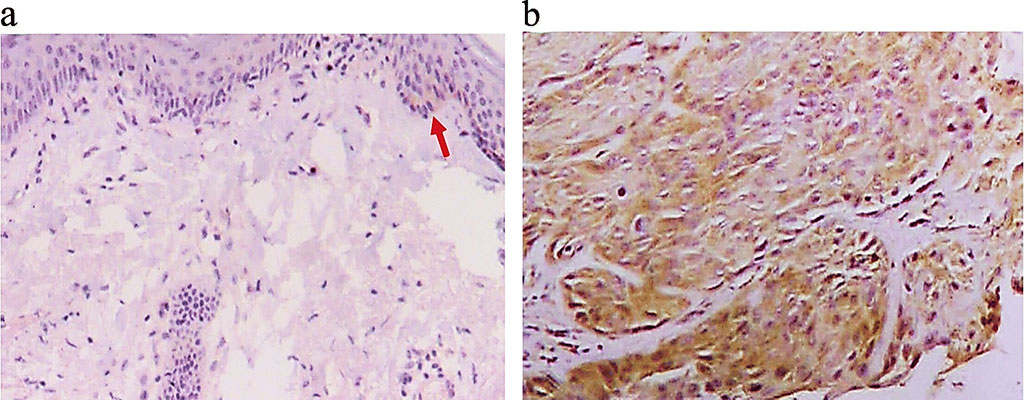Diagnostic Biomarker MMP-13 Explored for Cutaneous Squamous Cell Carcinoma
By LabMedica International staff writers
Posted on 27 Jul 2021
Cutaneous basal cell carcinoma (cBCC) and cutaneous squamous cell carcinoma (cSCC) account for approximately 80% and 20% of non-melanoma skin cancer (NMSC), respectively Although the majority of cSCCs are successfully eradicated by surgical excision, a subset of cSCC possesses features associated with a higher likelihood of recurrence, metastasis, and death.Posted on 27 Jul 2021
Matrix metalloproteinases (MMPs), a family of structurally related proteolytic enzymes, participate in the degradation of various extracellular matrix (ECM) components, e.g., collagen, elastin, fibronectin and gelatin. Dysregulation of MMPs has been found to be involved in diverse pathological conditions including arthritis, fibrosis and neoplasia.

Image: Immunohistochemical (IHC) analysis of the normal tissue from a healthy subject showed several Matrix Metalloproteinase-13 (MMP-13) positive cells (light brown staining indicated by the red arrow in panel a. Panel b is an IHC microphotograph for the cSCC tissue, and brown staining can be seen in most of tumor cells (Photo courtesy of Weifang People’s Hospital)
Dermatologists and their colleagues at the Weifang People’s Hospital (Weifang, China) conducted a case-control study to examine serum MMP-13 as a biomarker for cSCC. A total of 77 patients (49 males and 28 females) and 50 healthy individuals (33 males and 17 females) were included in the study. For patients, 57 cases of cSCC occurred in sun-exposed areas and 20 in the genital areas.
Serum MMP-13 was measured using the Human MMP-13 ELISA Kit (Sigma China Co., Ltd., Shanghai, China). The absorbance at 450 nm of each well was read using a microplate reader (BioTek, Winooski, VT, USA). Routine tissue fixation, paraffin-embedding and sectioning, inactivation of endogenous horseradish peroxidase (HRP) and antigen retrieval were performed as was immunohistochemistry (IHC).
The investigators reported that patients had significantly higher serum MMP-13 levels than healthy controls. Subjects with stage 3 cSCC had markedly higher serum MMP-13 levels than those with stage 1 and stage 2 cSCC. Patients with invasive cSCC had remarkably higher serum MMP-13 than those with cSCC in situ. Post-surgery serum MMP-13 measurement was done in 12 patients, and a significant MMP-13 decrease was observed after removal of cSCC.
Tumor tissues had a remarkably higher level of MMP-13 than control tissues. Serum MMP-13 predicted the presence of invasive cSCC with an AUC of 0.87 for sensitivity and specificity of 81.7% and 82.4%, respectively for a cut-off value of 290 pg/mL. Serum MMP-13 predicted lymph node involvement with an AUC of 0.94 for sensitivity and specificity of 93.8% and 88.5%, respectively for a cut-off value of 430 pg/mL.
The authors concluded that serum MMP-13 levels show high sensitivity and specificity for the differentiation of invasive cSCC and cSCC in situ, and the prediction of lymph node metastasis, suggesting serum MMP-13 might serve as a valuable biomarker for early detection of cSCC invasiveness and monitoring of cSCC progression. The study was published on July 15, 2021 in the journal BMC Cancer.
Related Links:
Weifang People’s Hospital
Sigma China Co., Ltd
BioTek














